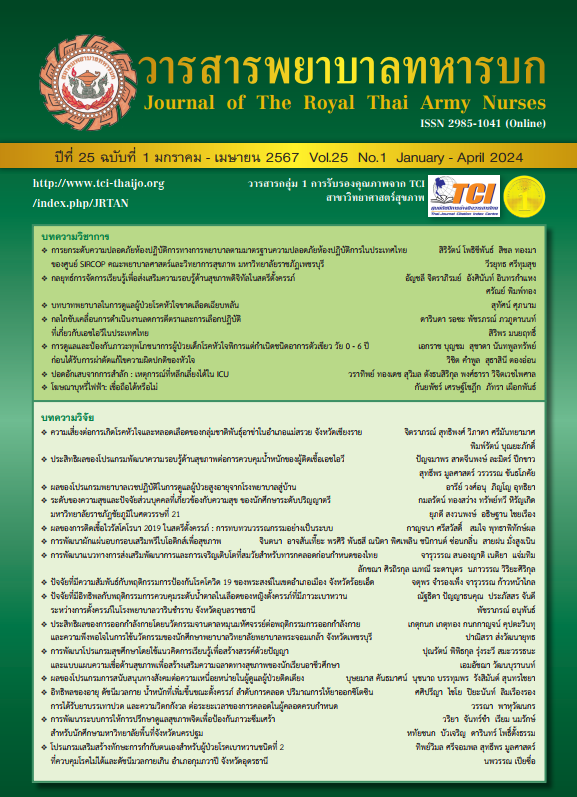The Effects of Clinical Nursing Practice Guidelines to Prevention & Care for Incontinence Associated Dermatitis in Patient Ward Somdech Phra Debaratana Building Faculty of Medicine Ramathibodi Hospital
Keywords:
clinical nursing practice guidelines, Prevention & care for incontinence associated dermatitisAbstract
The quasi-experimental research aimed to investigate the effects of clinical nursing practices in preventing and managing incontinence-associated dermatitis (IAD) in two phases. The sample included 39 patients at risk of IAD in both phases and 93 nurses, and 81 nursing assistants.Specific tools included personal information questionnaires, clinical practice assessment forms, patient satisfaction surveys, and staff opinion questionnaires. The content validity index was 1.00 for all tools. Statistical analysis involved t-tests and McNemar’s test.
Results indicated a significant reduction in IAD occurrences in phase 2, with higher patient satisfaction scores. Staff, especially nursing assistants, showed increased agreement with the use of clinical practices in phase 2. Overall, the study suggests that implementing these practices can enhance outcomes for both patients and healthcare providers.
Downloads
References
Doughty D, Junkin J, Kurz P et al. Incontinenceassociated dermatitis. Consensus statements, evidence-based guidelines for prevention and treatment, current challenges. The Journal of Wound, Ostomy and Continence Nursing 2012; 39(3):303-15.
Park KH, Choi H. Prospective study on incontinence-associated dermatitis and its severity instrument for verifying its ability to predict the development of pressure ulcers in patients with fecal incontinence. International wound journal 2016;13(1):20-5.
Campbell JL, Coyer FM, Osborne SR. Incontinenceassociated dermatitis: a cross-sectional prevalence study in the Australian acute care hospital setting. International wound journal 2016;13(3):403-11.
Banharak S, Panpanit L, Subindee S, et al. Prevention and Care for IncontinenceAssociated Dermatitis Among Older Adults: A Systematic Review. Journal of Multidisciplinary Healthcare. 2021;14:2983.
Beeckman D, Damme NV, Schoonhoven L, et al. Interventions for preventing and treating incontinence-associated dermatitis in adults. Cochrane Database Systemic Review 2016.
Kwangthong N. Danaidutsadeekul S. Watanakijkrilert D. Angspatt A. The Effects of Skin Care Protocol on Ulcer Healing in Patients with Incontinence-Associated Dermatitis. Kuakarun Journal of Nursing 2023;30(1):14–24. (in Thai)
Beeckman D et al. Proceedings of the Global IAD Expert Panel. Incontinence associated dermatitis: moving prevention forward. Wounds International 2021.
Ramathibodi Hospital.Incontinence-associated dermatitis annual report. Faculty of Medicine Ramathibodi Hospital; 2021. (in Thai)
Chartputhananun B. Effectiveness of Implementing the Clinical Practice Guidelines for Traumatic Wound Pain Management at Emergency Department in Middle-level Hospital. Journal of The Royal Thai Army Nurses 2017;18(2): 101-9. (in Thai)
Prechaterasat A. Enterostomal Therapy Nurse’s Role: Case Study in Nursing Care for Rectal Cancer Patients. Thai Red Cross Nursing Journal 2017;10(1):22-34. (in Thai)
Phakaew j, Choupram T, Thonghyuat N, Chansamrong P, Rodchomphu A, Maleewong K. Nurse’s role Enterostomal Therapy Nurse for patients with dermatitis problems due to incontinence associated dermatitis (IAD). Vajira nursing journal 2020;22(2): 127-34. (in Thai)
Jinaporn J, Temtap S, Nilmanat K. Comparison of Petroleum-Based Skin-Protection Product and Zinc Oxide-Based Skin-Protection Product on Incidence and the Level of Severity of Early Incontinence Associated Dermatitis in Hepatic Encephalopathy Patients with Incontinence. Journal of Public Health Nursing 2018;32(2): 59-80. (in Thai)
Li, Yi-Min; Lee, Henry Hsin-Chung; Lo, Yu-Ling; Chao, Hui-Lin. Perineal Assessment Tool (PAT-C): Validation of a Chinese Language Version and Identification of a Clinically Validated Cut Point Using ROC Curve Analysis. Journal of Wound, Ostomy and Continence Nursing 2019 46(2):150-3.
Utthiya P, Koetsawat R, Nuritanon J. Incidence and Factors Associated with Incontinence Associated Dermatitis in Patient Ward Somdech Phra Debaratana Building Faculty of Medicine Ramathibodi Hospital : A Retrospective Matched-Paired Case Control Study Design. Journal of The Royal Thai Army Nurses 2023;24(2):290-8. (in Thai)
Srisakhot K, Kuleelung P, Aungvanit B, Sondos B, Sriruksa S. Development of Integrated Discharge-Planning Programme for Stroke Patients. Journal of Thailand Nursing and Midwifery Council 2022;37(3):20-43. (in Thai)
Uppanisakorn S, Somma T, Vattanaprasan P, Boonyarat J. Prevention and Treatment of Incontinence-Associated Dermatitis (IAD) in Critical Patients Treated in the Intensive Care Unit of a Medical Ward. Thai Journal of Nursing Council 2015;30(2):86-100.
Herzberg F. Work and the nature of man. ed, editor. London: Crosby Lockwook Staples; 1968.
Yodkolkij T, Kanogsunthornrat N, Thiengthiantham R. Clinical Practice Guideline Implementation in Colorectal Disease Patients undergoing Abdominal Surgery. Thai Journal of Nursing and Midwifery Practice 2018;5(1):94-111. (in Thai)
Downloads
Published
How to Cite
Issue
Section
License
Copyright (c) 2024 Journal of The Royal Thai Army Nurses

This work is licensed under a Creative Commons Attribution-NonCommercial-NoDerivatives 4.0 International License.
บทความหรือข้อคิดเห็นใดใดที่ปรากฏในวารสารพยาบาลทหารบกเป็นวรรณกรรมของผู้เขียน ซึ่งบรรณาธิการหรือสมาคมพยาบาลทหารบก ไม่จำเป็นต้องเห็นด้วย
บทความที่ได้รับการตีพิมพ์เป็นลิขสิทธิ์ของวารสารพยาบาลทหารบก
The ideas and opinions expressed in the Journal of The Royal Thai Army Nurses are those of the authors and not necessarily those
of the editor or Royal Thai Army Nurses Association.






